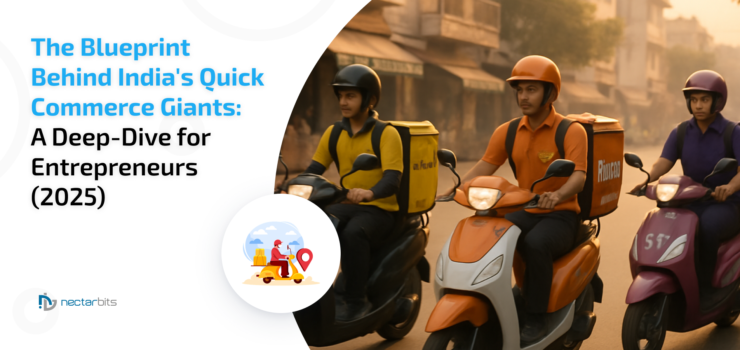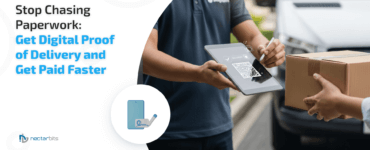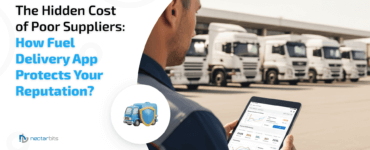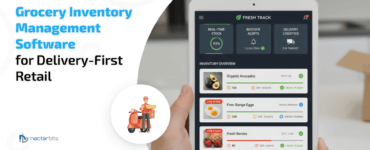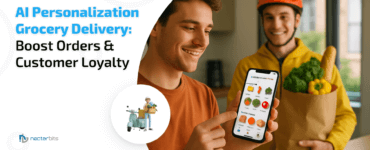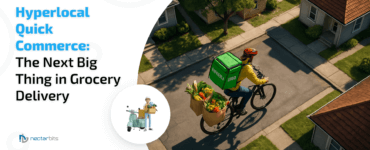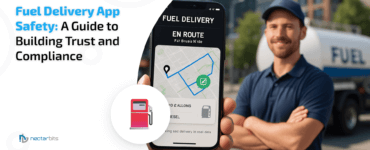In the bustling cities of India, a revolution is happening in 10-minute intervals. Quick commerce (q-commerce) platforms like Blinkit, Swiggy Instamart, and Zepto have transformed urban retail. For consumers, it’s about convenience. But for entrepreneurs, developers, and investors, it’s a masterclass in technology, logistics, and aggressive market strategy.
This isn’t just another comparison article. This is a business blueprint. We will dissect the engine that powers these giants, moving beyond the user-facing app to expose the technical architecture, financial models, operational hurdles, and strategic decisions required to compete in this high-stakes arena.
Part 1: Understanding the Battlefield – The Consumer-Facing Service
Before building, you must understand what you’re up against. Here’s a top-level look at the competition.
| Feature | Blinkit (by Zomato) | Swiggy Instamart | Zepto |
| Core Promise | 10-15 min delivery, vast catalog | 15-30 min delivery, widest reach | 10 min delivery, unmatched speed |
| Key Strength | Zomato ecosystem integration | Unparalleled Tier 2/3 city reach | Purpose-built for speed & efficiency |
| Target Audience | Price-sensitive metro dwellers | Existing Swiggy users across India | Urban purists who value speed above all |
This surface-level view reveals their market positioning. Now, let’s look under the hood.
Master Comparison: Three Companies, Three Playbooks
| Business & Tech Component | Blinkit (The Ecosystem Play) | Swiggy Instamart (The Logistics Powerhouse) | Zepto (The Tech-First Disruptor) |
| Core Business Strategy | Integrate grocery into a larger “super app” ecosystem (food, dining). | Leverage the existing food delivery network to dominate nationwide. | Win on pure speed and operational excellence. Be the fastest, always. |
| Primary Revenue Focus | Commissions & Ad revenue from Zomato’s massive user base. | Commissions & subscription fees from the all-encompassing Swiggy One. | Driving high order frequency & increasing average order value (AOV). |
| Backend Philosophy | Built for massive scale and integration with Zomato’s architecture. | Built for reliability and leveraging shared logistics data with food delivery. | Built for one thing: micro-second latency for inventory and route optimization. |
| Key Tech Differentiator | AI/ML for cross-selling recommendations from the Zomato ecosystem. | A unified logistics algorithm that dynamically allocates riders between food and grocery. | Proprietary real-time inventory system and hyper-optimized dark store tech. |
| Expansion Strategy | Deepen density in existing 30+ high value metro cities. | Go wide. Achieve unparalleled reach across 580+ cities, including Tier 2/3. | Go deep. Dominate 10+ major metros with an unmatched network of dark stores. |
| Inventory Strategy | Broadest possible catalog, expanding into electronics, beauty, etc. | Wide catalog with a focus on hyperlocal tastes and leveraging existing FMCG partnerships. | Highly curated, data-driven catalog of the fastest-moving 3,000-5,000 SKUs. |
| Est. Development Cost | High. Requires building a standalone app while ensuring deep API integration. | Highest. The complexity of integrating into a massive, existing super-app is immense. | Medium-High. Focused scope, but requires elite-level engineering for its core tech. |
| Your Market Entry Angle | Leverage the existing food delivery network to dominate nationwide. | If you have an existing logistics or delivery business you can leverage. | If you are starting fresh and want to win by being the best in a specific niche (e.g., gourmet, organic). |
Part 2: The Engine Room – Deconstructing the Technology Stack & Development
Q-commerce is a technology business first, and a retail business second. A flimsy tech stack means instant failure.
Detailed Comparison 1: The Technology Stack & Development Costs
Your choice here dictates your budget, timeline, and competitive edge.
- Swiggy Instamart’s Approach: The Integration Challenge
- Philosophy: Why build a new tech infrastructure when you have one of the country’s largest? Instamart is a complex layer built upon Swiggy’s mature, battle-tested backend.
- Advantage: Immediate access to a massive user base, payment systems, and logistics network.
- Disadvantage: This is the most complex and expensive path. The code must interact with a legacy system, making it slower to innovate and potentially more prone to bugs. The app can feel cluttered to users.
- For Entrepreneurs: Avoid this model unless you already run a large-scale platform. The integration cost and complexity are enormous.
- Blinkit’s Approach: The Hybrid Model
- Philosophy: Start with a standalone app, but build bridges. Blinkit maintains its own app but is deeply integrated with Zomato for user logins, loyalty programs (Zomato Gold), and advertising.
- Advantage: More agile than the fully integrated model. Can develop features independently while still benefiting from the parent company’s ecosystem.
- Disadvantage: Requires significant API management and can lead to a slightly disjointed user experience between the two apps.
- For Entrepreneurs: A viable model if you plan to launch a new vertical for an existing business.
- Zepto’s Approach: The Purpose-Built Machine
- Philosophy: Build from scratch, for speed. Zepto’s entire tech stack—from the frontend app to the backend inventory system—is designed for one purpose: fulfilling an order in under 10 minutes.
- Advantage: Lightning-fast, lean, and highly optimized. This singular focus allows for incredible operational efficiency and a superior user experience for its target customer.
- Disadvantage: Lacks a built-in user base, requiring massive marketing spend to acquire customers.
- For Entrepreneurs: This is the most recommended model for a new startup. It allows for focus, agility, and the chance to out-compete the giants in a specific niche through superior technology.
Technical & Development Gaps: The Anatomy of a Q-Commerce Platform
Here is a recommended technology stack for building a robust q-commerce platform:
| Component | Recommended Technologies & Tools | Key Considerations |
| Mobile App (Frontend) | Flutter or React Native | Cross-platform development saves immense time and cost for an MVP. Native is for mature, performance- critical stages. |
| Backend API | Node.js (for speed/I/O) or Python (Django/FastAPI) | Must handle thousands of concurrent requests. API design should be RESTful or GraphQL for flexibility. |
| Database | PostgreSQL (for relational data), MongoDB (for flexibility), Redis (for caching) | Requires a hybrid approach. Real-time inventory sync across thousands of SKUs is the single biggest database challenge. |
| Cloud Infrastructure | AWS, Google Cloud, or Azure | Start with serverless (AWS Lambda, Google Functions) to manage costs. Must be designed for auto-scaling during peak hours. |
| Mapping & Geolocation | Google Maps API, MapmyIndia | Critical for rider tracking, delivery zone fencing, and address verification. API call costs can be significant at scale. |
| Payments & Comms | Razorpay/PayU, Twilio/Gupshup | Integration with payment gateways and SMS/WhatsApp services for OTPs and order updates is essential. |
| Analytics & Monitoring | Mixpanel, Firebase, Grafana, Sentry | You must track user behavior, app performance, and system health from day one. |
Development Timeline & Costs: A Realistic Breakdown
Building a q-commerce app is a multi-million-dollar affair in the long run.
- Phase 1: Minimum Viable Product (MVP) – (4-6 Months)
- Features: User registration, product catalog, search, cart, basic online payments, manual order assignment, real-time rider tracking.
- Team Needed: 1 Project Manager, 2 Mobile Developers (Flutter/RN), 2 Backend Developers, 1 UI/UX Designer, 1 QA Tester.
- Approximate Cost: ₹40 Lakhs – ₹70 Lakhs ($50,000 – $85,000). This covers salaries and initial cloud/API costs.
- Phase 2: Full-Featured Application – (12-18+ Months)
- Features: AI-powered recommendations, advanced inventory management, automated rider assignment, membership programs, vendor portals, robust analytics.
- Team Needed: Expanded team with DevOps engineers, data scientists, and specialized developers.
- Approximate Cost: Running into crores of rupees ($150,000+), with significant ongoing operational costs for cloud infrastructure and third-party services.

Part 3: The Business Model – Following the Money
Profit margins in Q-commerce are razor-thin. Success depends on multiple revenue streams and ruthless efficiency.
Revenue Stream Analysis
- Commission from Brands/Vendors: A percentage fee (5-15%) charged on the product’s MRP. This is a primary revenue source.
- Delivery Fees: A fee charged to customers on small orders. Breakeven analysis shows a single delivery costs ₹50-₹80 (rider pay, fuel, support). This fee rarely covers the full cost and is more of a deterrent for tiny orders.
- Advertising Revenue: Brands pay premium fees for:
- Promoted Listings: Appearing at the top of search results.
- Homepage Banners: Visibility on the app’s main screen.
- Exclusive Launches: Launching a new product exclusively on the platform.
- Membership Programs (e.g., Zepto Pass): Creates a predictable, recurring revenue stream and locks in customer loyalty.
- Data Monetization: Selling anonymized purchasing data and consumer behavior insights to brands for market research.
Operational Challenges & Key Metrics
- Inventory Management: The biggest challenge. You need sophisticated forecasting to avoid both stock-outs (lost sales) and overstocking (wastage, capital lock-up).
- Customer Acquisition Cost (CAC): How much you spend (on ads, offers) to get a new customer. In this competitive space, CAC can be very high.
- Lifetime Value (LTV): The total profit you expect to make from a customer over their entire time with you. The golden rule of q-commerce is that LTV must be significantly greater than CAC.
Detailed Comparison : Business Model & Revenue Generation
How you make money is as important as what you sell.
| Revenue Strategy | Blinkit | Swiggy Instamart | Zepto |
| Primary Lever | Advertising. Uses Zomato’s platform to sell high-value ad space and promoted listings to FMCG brands. | Subscription. Pushes users towards the Swiggy One membership, creating stable, recurring revenue. | Frequency. Focuses on making the service so good that customers order multiple times a week, driving up LTV. |
| Pricing Strategy | Highly competitive, often running platform-wide discounts to drive Zomato’s overall Gross Order Value (GOV). | Competitive, with exclusive member-only pricing through Swiggy One to increase subscription value. | Transparent and competitive. Less reliant on deep discounts, more on service to retain customers. |
| Data Monetization | Sells macro-level consumer trend data, enhanced with Zomato’s dining data. | Sells rich, anonymized data on purchasing habits across both food and grocery. | Sells highly specific data on fast-moving goods and impulse buys within a 2km radius. |
Part 4: Your Go-to-Market & Scaling Strategy
You cannot take on Blinkit or Zepto head-on. You must be smarter.
Market Entry & Differentiation
- Identify an Underserved Niche: Don’t be a generalist. Start by specializing:
- Organic & Health Foods
- Gourmet & Imported Goods
- Pet Supplies
- Baby Care Products
- Late-Night Bakery & Snack Delivery
- Differentiate Beyond Speed: Competing on 10-minute delivery is a cash-burning game. Differentiate on:
- Curation: Offer unique products the giants don’t have.
- Quality: Be the “premium” or “freshest” option.
- Community: Build a brand that resonates with a specific lifestyle.
Regulatory & Compliance Checklist
- Business Licenses: Shop and Establishment Act, Trade License.
- Food & Safety: FSSAI license is non-negotiable for your dark stores.
- Taxation: GST registration is mandatory.
- Insurance: You need liability insurance for your operations and accident insurance for your delivery partners.
Step-by-Step Launch & Scaling Guide
- Market Validation (1-2 months): Before writing a single line of code, validate demand. Use surveys and landing pages in a target locality to gauge interest in your chosen niche.
- MVP Development (4-6 months): Build the core features. Prioritize a stable ordering and delivery experience above all else.
- Pilot Launch (3 months): Launch in a single, well-defined neighborhood. Operate from one dark store. Learn, iterate, and fix bugs. Track your KPIs obsessively (delivery time, order accuracy, customer complaints).
- Phased Expansion: Once your model is proven and unit economics are positive in the pilot area, expand methodically, one cluster of neighborhoods at a time.
- Partnerships vs. Ownership: Consider partnering with existing local retailers initially to reduce capital expenditure on dark stores, before moving to a fully-owned inventory model.
Detailed Comparison: Operations, Expansion & Risk
This is where the physical world meets your digital platform.
- Expansion & Dark Stores:
- Swiggy Instamart: Follows its food delivery network. This gives it an unbeatable head start in new cities but means dark store locations may be optimized for food, not necessarily for groceries.
- Blinkit: Focuses on saturating high-income, high-density areas within its existing cities to maximize the value from each dark store.
- Zepto: Uses a data-driven “cluster” approach. It won’t launch a city until it can open multiple dark stores in a tight cluster to guarantee speed and efficiency from day one.
- Risk Profile Comparison:
- Biggest Risk for Blinkit: High cash burn from deep discounting and intense competition, which can impact Zomato’s overall profitability.
- Biggest Risk for Swiggy Instamart: Brand dilution. If the grocery experience is poor, it can damage the core food delivery brand. The “all-in-one” app can become bloated.
- Biggest Risk for Zepto: Limited scale. Its model is expensive to scale and it may struggle to compete on price with the ecosystem players in the long run without a strong secondary revenue stream.
Your Playbook: Which Model Should You Choose?
Analyze your own resources and ambitions to pick your strategy.
- Choose the Zepto Model if:
- You are a tech-focused founder starting from scratch.
- You have identified a high-value niche (e.g., organic foods, pet supplies, electronics).
- Your goal is to build a superior product and user experience to win a loyal customer base, even if it’s smaller initially.
- Choose the Blinkit Model if:
- You already run a business with a large customer database (e.g., a media site, a fintech app).
- Your strategy is to launch a new service by cross-selling to your existing users.
- You have the capital to manage a broad inventory and compete on price.
- Choose the Swiggy Instamart Model if:
- You own an existing logistics, delivery, or retail business.
- Your core competency is in supply chain and physical operations, not just technology.
- Your goal is to achieve wide geographic coverage quickly by leveraging your current assets.
By understanding these fundamental differences, you can make an informed decision, avoid costly mistakes, and build a strategy that gives your venture the best possible chance of success.
The Final Takeaway: Your Actionable Blueprint
Building a q-commerce business is a monumental task, but it’s not impossible for a focused, strategic player.
- Start Small & Niche: Don’t fight the giants on their turf. Create your own.
- Be a Tech & Data Company: Your success will be defined by the quality of your technology and your ability to use data to make smart decisions.
- Obsess Over Unit Economics: Understand the cost and profit of every single order.
The q-commerce war has provided a treasure trove of lessons. By studying the blueprint of Blinkit, Zepto, and Instamart, a smart entrepreneur can avoid their mistakes and carve out a profitable space in the future of Indian retail.

FAQ
Quick commerce in India focuses on delivering groceries and essentials within 10–30 minutes using dark stores, advanced logistics, and real-time inventory management.
They earn through commissions from brands/vendors, delivery fees, in-app advertising, subscriptions (Swiggy One, Zepto Pass), and data monetization.
Building a q-commerce MVP costs around ₹40–70 lakhs ($50k–85k). A full-featured scalable platform can cross ₹1.5 crores ($150k+) depending on tech stack and features.
A robust stack includes Flutter/React Native (mobile), Node.js/Python (backend), PostgreSQL + Redis (database), and cloud hosting via AWS/Google Cloud.
Instead of competing on speed, startups can focus on niches such as organic foods, gourmet items, pet supplies, or late-night snacks with superior service and curation.


